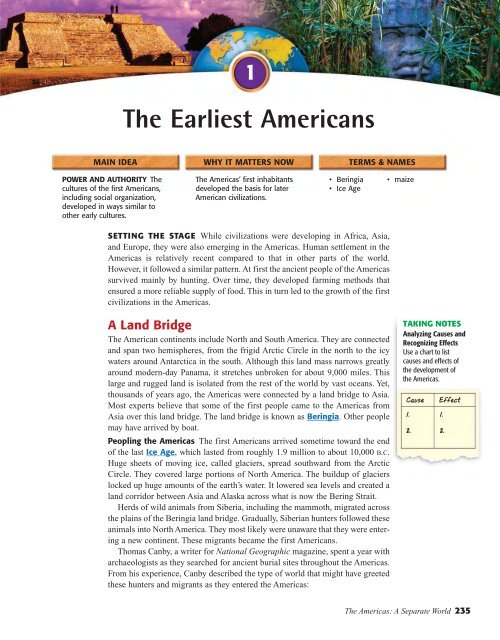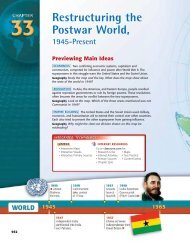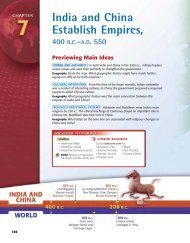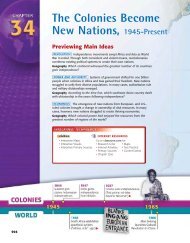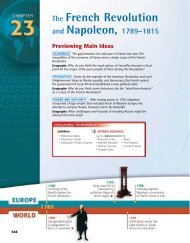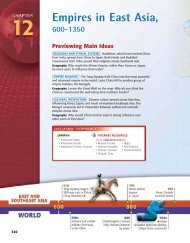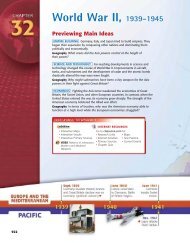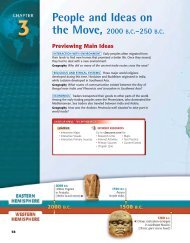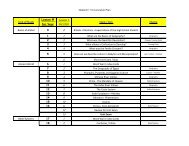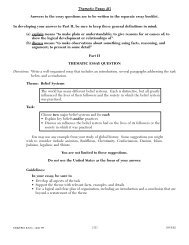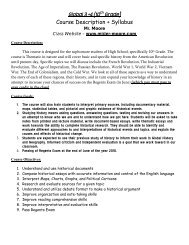The Americas: A Separate World, - First
The Americas: A Separate World, - First
The Americas: A Separate World, - First
Create successful ePaper yourself
Turn your PDF publications into a flip-book with our unique Google optimized e-Paper software.
MAIN IDEA WHY IT MATTERS NOW TERMS & NAMES<br />
POWER AND AUTHORITY <strong>The</strong><br />
cultures of the first Americans,<br />
including social organization,<br />
developed in ways similar to<br />
other early cultures.<br />
1<br />
<strong>The</strong> Earliest Americans<br />
<strong>The</strong> <strong>Americas</strong>’ first inhabitants<br />
developed the basis for later<br />
American civilizations.<br />
• Beringia<br />
• Ice Age<br />
SETTING THE STAGE While civilizations were developing in Africa, Asia,<br />
and Europe, they were also emerging in the <strong>Americas</strong>. Human settlement in the<br />
<strong>Americas</strong> is relatively recent compared to that in other parts of the world.<br />
However, it followed a similar pattern. At first the ancient people of the <strong>Americas</strong><br />
survived mainly by hunting. Over time, they developed farming methods that<br />
ensured a more reliable supply of food. This in turn led to the growth of the first<br />
civilizations in the <strong>Americas</strong>.<br />
A Land Bridge<br />
<strong>The</strong> American continents include North and South America. <strong>The</strong>y are connected<br />
and span two hemispheres, from the frigid Arctic Circle in the north to the icy<br />
waters around Antarctica in the south. Although this land mass narrows greatly<br />
around modern-day Panama, it stretches unbroken for about 9,000 miles. This<br />
large and rugged land is isolated from the rest of the world by vast oceans. Yet,<br />
thousands of years ago, the <strong>Americas</strong> were connected by a land bridge to Asia.<br />
Most experts believe that some of the first people came to the <strong>Americas</strong> from<br />
Asia over this land bridge. <strong>The</strong> land bridge is known as Beringia. Other people<br />
may have arrived by boat.<br />
Peopling the <strong>Americas</strong> <strong>The</strong> first Americans arrived sometime toward the end<br />
of the last Ice Age, which lasted from roughly 1.9 million to about 10,000 B.C.<br />
Huge sheets of moving ice, called glaciers, spread southward from the Arctic<br />
Circle. <strong>The</strong>y covered large portions of North America. <strong>The</strong> buildup of glaciers<br />
locked up huge amounts of the earth’s water. It lowered sea levels and created a<br />
land corridor between Asia and Alaska across what is now the Bering Strait.<br />
Herds of wild animals from Siberia, including the mammoth, migrated across<br />
the plains of the Beringia land bridge. Gradually, Siberian hunters followed these<br />
animals into North America. <strong>The</strong>y most likely were unaware that they were entering<br />
a new continent. <strong>The</strong>se migrants became the first Americans.<br />
Thomas Canby, a writer for National Geographic magazine, spent a year with<br />
archaeologists as they searched for ancient burial sites throughout the <strong>Americas</strong>.<br />
From his experience, Canby described the type of world that might have greeted<br />
these hunters and migrants as they entered the <strong>Americas</strong>:<br />
• maize<br />
TAKING NOTES<br />
Analyzing Causes and<br />
Recognizing Effects<br />
Use a chart to list<br />
causes and effects of<br />
the development of<br />
the <strong>Americas</strong>.<br />
Cause<br />
1.<br />
2.<br />
Effect<br />
1.<br />
<strong>The</strong> <strong>Americas</strong>: A <strong>Separate</strong> <strong>World</strong> 235<br />
2.


